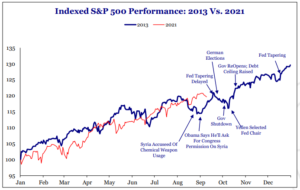Is It 2013 All Over Again?
September 17, 2021
To Inform:
We’ve seen a few personalities in the financial media call this month “The September to Remember” because there is a lot going on in the world. Let’s take a look at a non-exhaustive list:
- The Federal Reserve is meeting next week and talk is they will preview a “tapering plan” to reduce bond purchases and slow down the amount of liquidity they are injecting into the economy.
With next week’s meeting supposed to be the “warning to the market,” Goldman Sachs recently increased their odds of an official “taper announcement” happening in November to 70%.
- The United States has hit its debt limit and likely by late October, Congress will need to vote to increase the amount the U.S. Government can borrow. In the past, the debt ceiling increase process has been politically contentious and raises the possibility of a government shutdown.
- Geopolitically, there is a controversial withdrawal from Afghanistan.
- President Biden/The House of Representatives have proposed a $3.5 trillion dollar spending package, with significant tax increases proposed to help pay for it all.
- Fed Chair Powell’s current term is up early next year and President Biden will need to decide either to reappoint or replace Powell.
- The stock market looks expensive on some metrics with the S&P 500 up close to +20% YTD.
Wow – that’s a lot going on. With all of this happening, the market is bound to have volatility and experience a correction, right? Are there any periods in history where there has been a similar confluence of events?
One of our favorite phrases is “history never repeats itself, but often rhymes,” a quote credited to Mark Twain. When we look back at history, there are some uncanny similarities between today’s environment and the fall of 2013. For a blast from the past, here is some of what was happening eight years ago:
- The Federal Reserve was talking about rolling out a “tapering plan” to reduce bond purchases and slow down the amount of liquidity they were injecting into the economy.
- On August 26. 2013, Treasury informed Congress if the debt ceiling was not raised in time, the United States would be forced to default on its debt sometime in mid-October. Politicians could not agree on terms and the U.S. Government went into partial shutdown on October 1, 2013 until Congress passed a bill on October 16 suspending the debt ceiling until February 2014.
- Geopolitically, Syria’s use of chemical weapons crossed a “red line” previously identified by President Obama, raising the prospect of military intervention by the U.S.
- Health insurance exchanges were about to go live under the Affordable Care Act.
- Fed Chair Bernanke’s term was expiring and President Obama needed to appoint his replacement.
- The stock market looked expensive on some metrics with the S&P 500 up over +14% from the beginning of 2013 through September.
So, that’s a fun walk through memory lane and while certainly not exact, the similarities are fascinating. With all of that happening, the market had to have volatility and experience a big correction, right?
Here is the story in a picture, courtesy of Strategas Research Partners. In 2013 (blue line), the stock market bounced around in September and October, but was up 10.5% in the 4th quarter of 2013 (source: Morningstar). The red line on the chart shows the behavior of the market so far in 2021.

Source: Strategas Research Partners
Looking at current events through the eyes of what happened in 2013 is interesting, but can we learn anything else beyond a history lesson? In our office, TJG Portfolio Manager Alex Durbin and I exchange a lot of emails. On Tuesday he sent me an article concerning behavioral finance and pulled out the following quote:
“The potential to improve our results by understanding and managing our behaviour (it was a British article) outstrips any other changes we could make that might enhance our investment fortunes. – Joe Wiggins
While history may not repeat itself, it gives us a lens through which we can test our investment assumptions before we act. In late 2013, it looked like the world was experiencing its fair share of turmoil and it seemed like the best investment behavior was to get more defensive. History shows that would have been the wrong choice.
Today, we’ve had a lot of conversations about the turmoil in the world and whether it means we should get more defensive in the portfolios we have the privilege of managing on behalf of our clients. The lessons from history suggest the best way to manage our investment behavior is to seek to have portfolios which have the ability to succeed based on a range of outcomes in the current environment rather than react emotionally to what “should” happen.

Written by Travis Upton, Partner, CEO & Chief Investment Officer